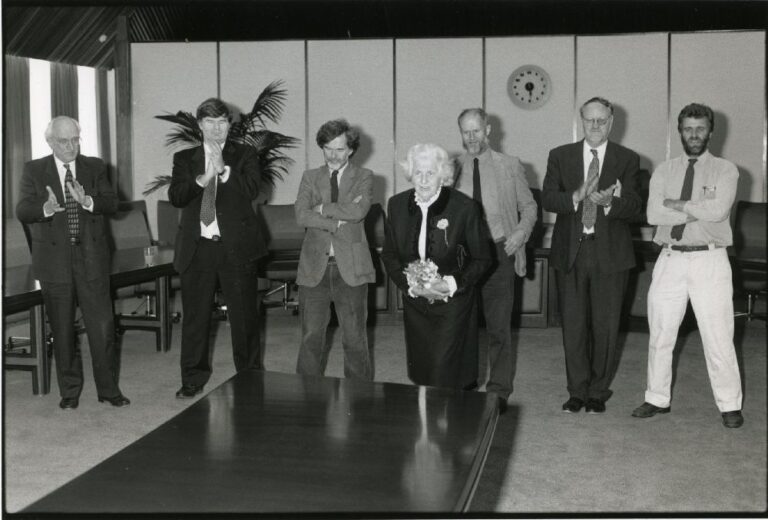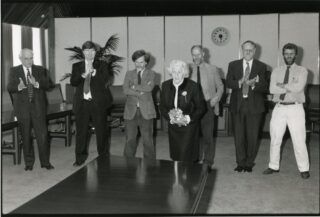- Entry type: Person
- Entry ID: AWE4844
Clark, Hilma Dymphna
(1916 – 2000)
- Born 18 December 1916, Melbourne, Victoria, Australia
- Died 12 May 2000, Canberra, Australian Capital Territory, Australia
- Occupation Linguist, Teacher
Summary
Born to Belgian and Scandinavian parents, Hilma Dymphna Lodewyckx grew up surrounded by languages which, combined with a natural talent, saw her master over eight languages and become a successful linguist. Her most ambitious and important work was a translation from German to English of Baron Carl von Hügel’s New Holland Journal. After meeting her future husband Manning Clark at Melbourne University, the couple journeyed to Germany and England, respectively, to continue their studies. They married at Oxford in 1939. Returning to Australia to escape the war in Europe, the couple and their growing family eventually settled in Canberra where Manning took up a position at what would become the Australian National University. Dymphna worked to raise her young family and establish their home as a warm welcoming space for friends and colleagues, as well as assisting Manning with translations and editing for his historical works. By 1959 Dymphna returned to teaching, eventually taking up a position at the ANU German Department. She was also an activist for Aboriginal rights and the environment. After Manning’s death in 1991 Dymphna worked tirelessly to turn the home they shared into Manning Clark House – a cultural hub for scholars, artists and writers. Today, Manning Clark House still plays a vital role in the Canberra community.
Details
Anna and Augustin Lodewyckx welcomed their daughter Hilma Dymphna into their family on 18 December 1916. Their daughter inherited her first name from her mother’s Scandinavian side of the family, while Dymphna, the name by which she would be known, came from her father’s Belgian heritage. Her mother, Anna Sophia, and her father Augustin between them spoke many languages, but the working language of their home was Dutch except at dinner time when it was French or German if there were no guests. With such cultural backgrounds the couple educated and raised their daughter, and her older brother, Axel, in something akin to a ‘little Europe’ in suburban Melbourne. Here, Dymphna developed her considerable linguistic talents. She learnt perfect German from her father during formal lessons and picked up Swedish from listening to the exchanges between her mother and grandmother. All told Dymphna learned 12 languages, though she claimed to be fluent in eight and only ‘getting by’ in the other four. Anna ran the family home alongside teaching duties at Melbourne University where she taught Swedish, and played a key role in the promotion of the language and culture throughout the state, while Augustin worked first at Melbourne Grammar School and then later in 1916 took an appointment at the University of Melbourne as lecturer in German. Before settling in Melbourne at the outbreak of the Great War the couple had lived in Europe, South Africa and the Belgian colony, the Congo, before finally settling in the Antipodes in 1914.
This melting pot of culture and experience no doubt nurtured Dymphna’s talent for language, but it also coloured her childhood in a distinctly European way. Her brother Axel recalled life at ‘Huize Eikenbosch’ (the name Augustin gave the family home due to the plethora of European oak trees he planted in the gardens) in the 1920s as a place where you would hear students learning German, and as a place to watch his parents and their friends waltz around the living room practising the latest European dances. Dymphna’s father would spend many hours in the garden cultivating and tending it in Flemish ways, possibly sparking Dymphna’s later love for plants and gardening. Her mixed cultural heritage at times made her feel as if she had split identities, and she often had trouble with her name at school as there were not many other migrants around. Still, she recalled her childhood as enriching and making her feel as though she could do anything. By 15 she had matriculated from Presbyterian Ladies’ College and from there went to Munich in 1933 with her mother to study for a year at the Mädchenreformrealgymnasium an der Lusienstrasse. She returned to Melbourne in 1934 to study German at Melbourne University. Here her ‘Europeanness’ was once again made apparent to her, as she was often being called the ‘mad girl without a hat or without stockings’ due to her casual European style of dress which stood out compared to the formal styles of her Australian peers.
It was at Melbourne University in her last year of studies that she met her future husband, and future eminent and controversial historian, Charles Manning Hope Clark. Dymphna left behind no autobiographical writings and remained steadfastly silent on her courtship and marriage to Manning, though her husband describes a passionate and warm courtship in his memoirs and letters. After graduating from Melbourne University, Dymphna won the Mollison travelling scholarship which saw her go to Germany again. This time she studied Greek and Latin at Bonn University. For her it was as much a chance to indulge her passion for travel as to further her education. Although she would later recall that she ‘never really found her feet’ at Bonn, Nazi Germany still proved to be an awakening of sorts. She recalled learning in this period that politics was real and remembered sneaking off once a week to read British newspapers to find out what was going on in Germany. Yet she still felt herself succumbing to the all-pervasive Nazi propaganda, and understood how so many people became so mesmerised by the regime.
As threats of war grew, Manning called for Dymphna to come to England where he was studying for his doctorate at Balliol College, Oxford. She joined him and they married in Oxford on 31 January 1939. During this period she worked as a teacher at Blundell’s School in Devon, but found her surrounds depressing. She and Manning welcomed their first child, Sebastian, in December 1939. He would be the first of six children. In 1940 the family decided to return to Australia where Manning took up a teaching position at Geelong Grammar School. In 1949 the Clark family moved to Canberra so that Manning could become the first Professor of History at the Canberra University College, later incorporated into the Australian National University. Over the next 16 years Dymphna’s time was primarily taken up with the business of mothering children, running a household and supporting her husband and his academic research. She also found time to indulge in her passion for gardening and plants. She provided most of the produce to feed her family from her vegetable gardens and chicken sheds. Her friends recall the Clark house as being a site for scholarship and learning, but also an extraordinarily warm and friendly place where many delicious meals and good conversations amongst friends could be had.
In 1959, Dymphna returned to her teaching at the Soviet Embassy where she taught English to diplomats. She followed this appointment with one at the German Department of the Australian National University. Here, her talents as a formidable scholar in her own right were able to shine. She worked with Peter Sack from the German Department on a nine-year project translating from German to English the reports of the Governor of German New Guinea from 1886 to 1914. However, her most ambitious and important work was the translation of Baron Carl von Hügel’s New Holland Journal. Published in 1994, it provided for the first time in English the Austrian botanist’s daily diaries of his expeditions in Australia and New Zealand in the 1830s. Alongside her own work Dymphna did many translations of documents and material for Manning’s historical works, as well as proofreading, editing and assisting him in his research for some of his major works including A History of Australia.
Dymphna also became an activist for Aboriginal rights, becoming a member of the Aboriginal Treaty Committee in 1980 which aimed to educate and promote the need for a formal treaty between Indigenous people and the Federal Government. She also wrote the Committee’s preamble that was to be reviewed by Parliament. Dymphna continued her lifelong passion for the environment and gardening by working with Greening Australia Volunteers to plant over a thousand trees on the Clark’s property ‘Ness’ in Wapengo on the New South Wales south coast.
In 1991 Dymphna’s long marriage to Manning ended with his death on 23 May. She continued to work at her own projects, as well as being an avid defender of her late husband and his work. In 1993 Manning’s most famous work, A History of Australia, was attacked by his own publisher, Peter Ryan, while in 1996 the Brisbane Courier Mail alleged Manning had been a Soviet spy – an allegation Dymphna’s work at the Soviet Embassy helped to fuel. These allegations were all later resoundingly discredited. Dymphna also compiled and donated her own and Manning’s papers to the National Library of Australia, and with the assistance of her son Sebastian edited and published Manning’s final works, An Historian’s Apprenticeship (1992) and Speaking out of Turn (1997), a volume of his speeches and lectures between 1940 and 1991. Dymphna also established Manning Clark House (the family’s home in Forrest, Canberra) as a cultural hub for scholars, writers and artists. The house has grown to be a vital and vibrant part of the Canberra arts and academic communities. Having kept her diagnosis of cancer private, telling only a few close people, Hilma Dymphna Clark passed away on 12 May 2000.
Archival resources
- National Library of Australia
- National Library of Australia, Manuscript Collection
-
National Library of Australia, Oral History and Folklore Collection
- Dymphna Clark interviewed by Heather Rusden and Elizabeth Cham [sound recording]
- Dymphna Clark interviewed by Heather Rusden [sound recording]
- Manning Clark and Dymphna Clark speak for the Aboriginal Treaty Committee on mining in Noonkanbah, W.A. in the 2XX collection [sound recording] / interviewer, Stuart Reid
- Andrew Clark interviewed by Susan Marsden [sound recording]
- Interview with Prof. Katerina Clark, academic & Dr. Axel Clark, academic [sound recording] / interviewer, Susan Marsden
- Sebastian Clark interviewed by Susan Marsden [sound recording]
- Rowland Clark interviewed by Susan Marsden [sound recording]
Digital resources
Published resources
- Book
- Edited Book
- Newspaper Article
-
Site Exhibition
- From Lady Denman to Katy Gallagher: A Century of Women's Contributions to Canberra, Australian Women's Archives Project, 2013, http://www.womenaustralia.info/exhib/ldkg
-
Resource
- Trove: Clark, Hilma Dymphna (19161218-20000512), http://nla.gov.au/nla.party-1665899
